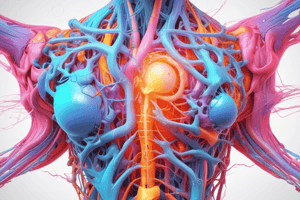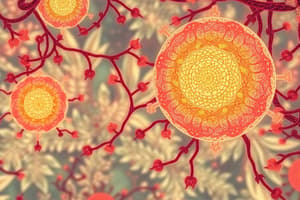Podcast
Questions and Answers
What does the term 'homeostasis' primarily refer to in regard to the body?
What does the term 'homeostasis' primarily refer to in regard to the body?
- The maintenance of a stable physiological state (correct)
- The ability to function in extreme conditions
- The development of independent cellular environments
- A permanent state of equilibrium
What component is NOT mentioned as a factor in homeostasis?
What component is NOT mentioned as a factor in homeostasis?
- Glucose levels
- Oxygen levels (correct)
- CO2 levels
- Temperature
What is the primary function of the fluid bathing cells in large animals?
What is the primary function of the fluid bathing cells in large animals?
- To regulate hormone levels
- To provide nutrients and absorb waste (correct)
- To connect cells with external stimuli
- To enhance cellular growth
How does the internal environment of complex organisms benefit their cells?
How does the internal environment of complex organisms benefit their cells?
Which aspect of homeostasis involves auto-regulatory processes?
Which aspect of homeostasis involves auto-regulatory processes?
What percentage of total body water in humans is typically found within cells?
What percentage of total body water in humans is typically found within cells?
What does the term 'homios' in homeostasis refer to?
What does the term 'homios' in homeostasis refer to?
What allows most cells in large animals to thrive despite not being in direct contact with the external environment?
What allows most cells in large animals to thrive despite not being in direct contact with the external environment?
What is the primary function of insulin in blood glucose control?
What is the primary function of insulin in blood glucose control?
How does the liver respond to high blood glucose levels?
How does the liver respond to high blood glucose levels?
What role do hormones play in blood glucose regulation?
What role do hormones play in blood glucose regulation?
Which of the following processes does the liver NOT perform when blood glucose is low?
Which of the following processes does the liver NOT perform when blood glucose is low?
What is a characteristic of homeothermic animals?
What is a characteristic of homeothermic animals?
What is the significance of temperature sensitivity in physiological processes?
What is the significance of temperature sensitivity in physiological processes?
How do animals typically maintain their body temperature?
How do animals typically maintain their body temperature?
What happens when blood glucose levels are excessively high?
What happens when blood glucose levels are excessively high?
What happens to the metabolic rate of endotherms in the thermoneutral zone?
What happens to the metabolic rate of endotherms in the thermoneutral zone?
Which behavior is typically observed in endotherms during cooling?
Which behavior is typically observed in endotherms during cooling?
Which physiological response occurs in endotherms when they need to warm up?
Which physiological response occurs in endotherms when they need to warm up?
How does vasodilation affect blood flow in endotherms?
How does vasodilation affect blood flow in endotherms?
What triggers the negative feedback mechanism for temperature control in endotherms?
What triggers the negative feedback mechanism for temperature control in endotherms?
What is a primary characteristic of ectothermic animals?
What is a primary characteristic of ectothermic animals?
What role does the autonomic nervous system play in temperature regulation?
What role does the autonomic nervous system play in temperature regulation?
What is the basal metabolic rate (BMR) of an endotherm?
What is the basal metabolic rate (BMR) of an endotherm?
Which of the following methods do ectothermic animals use to regulate their body temperature?
Which of the following methods do ectothermic animals use to regulate their body temperature?
Which of the following is NOT a method by which endotherms cool themselves?
Which of the following is NOT a method by which endotherms cool themselves?
How do endothermic animals maintain their body temperature?
How do endothermic animals maintain their body temperature?
Which statement about ectothermic animals is true?
Which statement about ectothermic animals is true?
What is a key difference between land and aquatic ectothermic animals in terms of temperature control?
What is a key difference between land and aquatic ectothermic animals in terms of temperature control?
What do endothermic animals require compared to ectotherms?
What do endothermic animals require compared to ectotherms?
Why might some invertebrates not behave like typical ectothermic animals?
Why might some invertebrates not behave like typical ectothermic animals?
Which of the following is NOT a characteristic of endothermic animals?
Which of the following is NOT a characteristic of endothermic animals?
Flashcards
Homeostasis
Homeostasis
Maintenance of a stable internal environment within narrow limits, allowing for optimal body functioning.
Physiological State
Physiological State
The conditions within the body that are tightly regulated to ensure optimal function.
Auto-regulatory Processes
Auto-regulatory Processes
These are the processes that automatically adjust and maintain the internal environment within specified ranges.
Internal Environment
Internal Environment
Signup and view all the flashcards
Intracellular Fluid
Intracellular Fluid
Signup and view all the flashcards
Extracellular Fluid
Extracellular Fluid
Signup and view all the flashcards
Plasma
Plasma
Signup and view all the flashcards
Interstitial Fluid
Interstitial Fluid
Signup and view all the flashcards
Homeostatic control
Homeostatic control
Signup and view all the flashcards
Blood glucose homeostasis
Blood glucose homeostasis
Signup and view all the flashcards
Insulin
Insulin
Signup and view all the flashcards
Glucagon
Glucagon
Signup and view all the flashcards
Temperature sensitivity of cells
Temperature sensitivity of cells
Signup and view all the flashcards
Poikilothermic animals
Poikilothermic animals
Signup and view all the flashcards
Homeothermic animals
Homeothermic animals
Signup and view all the flashcards
Control of body temperature
Control of body temperature
Signup and view all the flashcards
Ectothermic animals
Ectothermic animals
Signup and view all the flashcards
Endothermic animals
Endothermic animals
Signup and view all the flashcards
Metabolic rate of ectotherms
Metabolic rate of ectotherms
Signup and view all the flashcards
Energy usage in ectotherms
Energy usage in ectotherms
Signup and view all the flashcards
Temperature control in ectotherms
Temperature control in ectotherms
Signup and view all the flashcards
Metabolic rate of endotherms
Metabolic rate of endotherms
Signup and view all the flashcards
Temperature regulation in endotherms
Temperature regulation in endotherms
Signup and view all the flashcards
Activity of endotherms
Activity of endotherms
Signup and view all the flashcards
Thermoneutral zone
Thermoneutral zone
Signup and view all the flashcards
Basal metabolic rate (BMR)
Basal metabolic rate (BMR)
Signup and view all the flashcards
Vasoconstriction
Vasoconstriction
Signup and view all the flashcards
Vasodilation
Vasodilation
Signup and view all the flashcards
Negative feedback
Negative feedback
Signup and view all the flashcards
Hypothalamus
Hypothalamus
Signup and view all the flashcards
Physiological responses to temperature change
Physiological responses to temperature change
Signup and view all the flashcards
Study Notes
Homeostasis Overview
- Homeostasis is the maintenance of a stable internal environment within set parameters, despite external changes
- This is achieved through auto-regulatory processes
- A narrow range of physical and biochemical conditions is optimal for bodily functions. Factors include glucose, ion levels, osmotic pressure (water and solute concentration), CO2 levels, and temperature.
Homeostasis Model
- A model of homeostasis illustrates how large external fluctuations impact the internal environment, which is controlled by homeostatic systems to impact cells within the body. Small internal fluctuations impact cells in the body.
The Internal Environment
- Most large animal cells do not directly interact with their external environment
- Their internal environment (fluid) contains nutrients, removes waste, and provides a stable setting for cellular processes
- The internal environment is in part composed of extracellular fluid. Approximately 60% of humans is water, with 20% of that being plasma, and 80% being interstitial fluids.
Homeostasis and Occupying Diverse Habitats
- Homeostasis makes it possible to occupy habitats that would harm cells directly exposed to those external environments
General Scheme of Homeostatic Control
- The overall scheme for homeostatic control includes a negative feedback loop
- A norm set point signals either an excess or a deficiency, which triggers corrective mechanisms
- A series of negative feedback loops maintain the internal environment around this set point
Blood Glucose Control
- Blood glucose levels must be kept constant
- Glucose enters blood stream from the small intestine to the liver
- Liver can either:
- Conduct cellular respiration
- Convert it into glycogen for storage
- Convert it into fat for storage
- Release into circulation
Blood Glucose Homeostasis by Insulin and Glucagon
- Blood glucose is regulated by hormones insulin and glucagon
- Insulin is produced by the beta cells when blood glucose is high
- Glucagon is produced by the alpha cells when blood glucose drops
- Both work via negative feedback to return blood glucose to the set point around 90 mg/100 mL.
Temperature Sensitivity
- Cells function optimally between ~0°C and ~40°C
- Biochemical reactions are not all affected equally by temperature changes.
Control of Body Temperature
- Animals receive heat energy from the sun and through cellular respiration
- Warm-blooded (endotherms) vs. Cold-blooded (ectotherms)
- Poikilothermic vs. homeothermic
- Ectothermic animals obtain heat from their environments, whereas endotherms generate heat internally
Ectothermic Animals
- Require less food than endotherms
- Have lower metabolic rates
- Do not use energy to maintain temperature
- Use behavioral methods (e.g., basking, seeking shade) to control body temperatures
- Ectothermic Aquatic animals do not fluctuate greatly in temperature. Ectothermic land animals gain or lose heat based on their surroundings.
Endothermic Animals
- Require large quantities of food
- Have higher metabolic rates
- Use energy to maintain temperature
- Utilize behavioral and physiological mechanisms (e.g. shivering, sweating) to regulate temperature.
- Activity periods can be extended across a wide spectrum of weather.
Relationship between Environment and Body Temperature
- The graph shows a correlation between ambient temperature and the body temperature of endotherms (bobcats) and ectotherms (snakes). Ectothermic animal body temperature matches the ambient, while endotherms fluctuate less.
Aquatic Animals (Ectotherms)
- Water temperature is relatively stable
- Body temperature matches the water temperature
- Some fish are considered "hot" fish as they maintain temperatures higher than the ambient water.
Land Animals (Ectotherms)
- Land temperatures vary significantly
- Acquire heat from sunlight and ground, so they are more active than aquatic ectotherms
- Use behavioral methods (e.g., basking, seeking shade) for temperature control
Ectothermic Invertebrates
- Some invertebrates are not ectothermic (e.g., social insects/flying insects)
Heat Exchange - Ectotherms
- Heat exchange occurs through conduction, convection, radiation, and evaporation
Endotherms
- Respond to temperature changes by adjusting metabolic rate
- In the thermoneutral zone, metabolic rate is low and independent of temperature;
- Basal metabolic rate (BMR) is the metabolic rate of a resting animal in the thermoneutral zone.
Endotherm BMR
- A graph shows BMR relative to body mass
- Smaller animals tend to have higher BMRs per unit of mass.
Outside the Thermoneutral Zone
- Endotherms use behavioral and physiological mechanisms to maintain optimal body temperature when outside the thermoneutral zone
- Behavioral responses include seeking shade, huddling together, etc
- Physiological responses include shivering, vasodilation, sweating, etc.
- Metabolic rate increases in both warming and cooling states.
Vasodilation and Vasoconstriction
- Vasodilation increases blood flow to the skin; promotes heat loss
- Vasoconstriction restricts blood flow; reduces heat loss
Hypothalamus' Role in Temperature Control
- The hypothalamus acts as a thermostat for controlling body temperature
- Negative feedback loops regulate temperature by adjusting metabolic rate, blood vessel dilation, shivering, sweating, and behavioral changes.
Studying That Suits You
Use AI to generate personalized quizzes and flashcards to suit your learning preferences.




